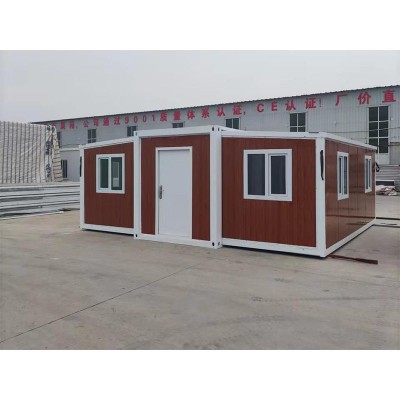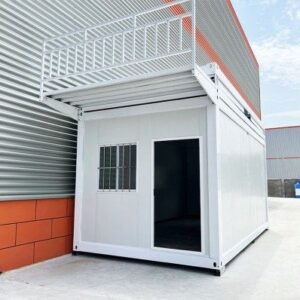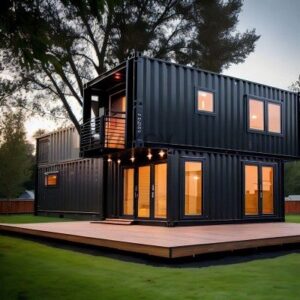When thinking about How Much Is A Shipping Container House, it’s important to break down the basic costs involved in 2025.
Basic Shipping Container Shell Price Range
- Used container prices: Usually range from $1,500 to $3,000 per container.
- New containers: Can cost anywhere from $3,000 to $5,000 each depending on size and condition.
These prices cover just the container shell itself—no modifications, insulation, or finishes.
Cost for a Finished Shipping Container Home
Once you factor in building a livable, finished home, prices jump significantly. A completed shipping container house typically costs between $20,000 and $150,000 or more depending on features and customization.
- Smaller, simple one-container homes start near $20,000 to $40,000.
- Larger modular or multi-container homes with full amenities can range up to $150,000+.
Cost Per Square Foot Compared to Traditional Homes
- Shipping container homes usually cost $150 to $300 per square foot, depending on design complexity.
- Traditional homes in the U.S. average $100 to $200 per square foot, but this can vary widely with location and materials.
While container homes can be more expensive per square foot in some cases, the savings often come from faster build times and fewer materials.
Key Points on Costs
- Container price is just the start.
- Finishing, insulation, permits, and utilities add up fast.
- Location and labor costs heavily influence final price.
- Modular builds or complex designs push costs higher.
Understanding this helps set realistic expectations when budgeting for your shipping container home project.

What Is a Shipping Container House
A shipping container house is a home built using steel shipping containers as the main structure. Originally designed to transport goods worldwide, these containers are repurposed into livable spaces. This concept offers a modern, cost-effective alternative to traditional construction, appealing to those looking for durability and innovative design.
Types of Shipping Container Houses
There are several common types of container homes, each serving different needs:
- Single Container HomesMade from one 20 or 40-foot container, these are popular as tiny homes or guest houses. They offer a compact and efficient living space.
- Multi Container HomesCombining multiple containers allows for larger floor plans, including multiple bedrooms and living areas. Containers can be stacked or placed side by side.
- Modular Container HomesThese are pre-designed kits or custom combinations offering scalable solutions. They’re often built off-site and assembled quickly on location.
Advantages of Shipping Container Homes
Shipping container homes offer a unique blend of benefits that make them worth considering:
- DurabilityContainers are made from weatherproof steel engineered to withstand harsh environments, providing a strong and secure living space.
- SustainabilityReusing shipping containers reduces waste and lowers the carbon footprint compared to conventional building materials.
- AffordabilityThe base cost of containers is relatively low, making them an economical choice for building a home, especially when paired with thoughtful design and customization.
- FlexibilityContainers can be customized with insulation, windows, doors, and various interior finishes to suit any lifestyle.
Breakdown of Shipping Container House Costs What Influences the Price
When figuring out how much a shipping container house costs, several key factors come into play. Understanding these helps you plan your budget and avoid surprises.
Container Type and Size
- New vs Used ContainersNew containers cost more—typically $3,000 to $5,000 each—but offer better structural integrity and come free of wear and tear. Used containers can be found from $1,500 to $3,000, but may need repairs or extra prep work.
- Standard Dimensions and SizesThe most common container sizes are 20 feet (around 160 sq ft) and 40 feet (around 320 sq ft). Larger or specialty sizes push prices higher, and the size impacts both the number of containers needed and foundation requirements.
- Customization OptionsCutting openings for windows and doors, adding insulation, or reinforcing the structure will add to costs.
Design and Customization
Your design choices hugely affect the price. Key elements include:
- Interior FinishesBasic drywall and paint are affordable. Upgraded flooring, custom cabinetry, or high-end appliances will increase costs.
- Insulation and WallsProper insulation is critical for US climates and often ranges between $3,000 to $10,000 depending on materials like spray foam, rigid panels, or blanket insulation.
- Plumbing and Electrical SystemsInstallation costs vary but expect $10,000 to $25,000 for full plumbing and electrical hookups, depending on complexity.
- Windows and DoorsAdding quality windows and exterior doors designed for insulation and security also drives up the price.
- Structural ModificationsReinforcing containers for stacking or combining multiple units adds several thousand dollars.
Location and Permitting
Where you build matters a lot:
- Site Preparation and FoundationGround prep, grading, and foundation setup can cost $5,000 to $20,000, depending on soil type and size of the build.
- Permits and ZoningLocal building codes and zoning laws affect price and timing. Permits can run from $500 to $3,000 or more and often require professional inspections.
- Impact on PriceSome areas have strict container home regulations leading to extra compliance costs.
Labor and Installation
- DIY vs Hiring ProfessionalsDoing it yourself reduces labor costs but requires skills and time. Hiring contractors increases costs but ensures faster, code-compliant builds.
- Shipping and Crane CostsTransporting containers to the site and placing them with cranes typically adds $2,000 to $8,000 depending on location and complexity.
Utilities and Additional Features
Adding comfort and efficiency affects your budget:
- Heating and Cooling SystemsHVAC installation can range from $5,000 to $15,000 based on system type and home size.
- Solar Panels and Green InfrastructureSolar setups and rainwater systems offer long-term savings but add upfront costs of $10,000+.
- Optional Add-OnsDecks, patios, smart home tech, and landscaping charges vary widely and should be factored into your planning.
Comparing Shipping Container Houses to Traditional Homes
Cost Effectiveness of Shipping Container Homes
Shipping container houses are often more affordable upfront compared to traditional homes. The basic shell of a container costs between $1,500 and $5,000, which is a fraction of the price for building conventional frame walls. Even after customization and finishing, a shipping container home generally falls in the $20,000 to $150,000 range, depending on size and features. This is usually less per square foot than traditional houses, which average around $100 to $200 per square foot.
Because container homes use repurposed steel boxes, there’s less material waste, which keeps costs lower. Plus, many of the parts are factory-produced, making some elements easier and cheaper to install.
Faster Build Times
One of the biggest advantages is speed. Traditional homes can take months to build, while a container house can be assembled and made livable in a matter of weeks. That includes delivery, site prep, installation, and finishing. The modular nature means containers arrive ready to stack and connect, speeding up construction.
Quicker build time means less money spent on labor and fewer temporary housing costs, which adds up to overall savings.
Long Term Savings and Durability
Shipping container homes are durable and low-maintenance. Made from strong, weatherproof steel, they resist pests, mold, and extreme weather better than wood-framed houses. This resilience can translate into savings on repairs and upkeep over the years.
They’re also well insulated and can be equipped with energy-efficient windows, solar panels, and other green tech, cutting down on utility bills. Many container homeowners report lower energy costs compared to traditional houses because of the tight, insulated design.
of Key Differences
| Feature | Shipping Container Home | Traditional Home |
|---|---|---|
| Initial Cost | Lower ($20K–$150K+) | Higher ($100+/ft² typically) |
| Build Time | Weeks | Months |
| Durability | High (steel frame, weatherproof) | Moderate (wood, brick, etc.) |
| Maintenance | Low | Higher |
| Energy Efficiency | Often better with insulation, solar options | Varies, typically standard |
| Customization Flexibility | Modular, but limited by container size | More flexible but costly |
In short, shipping container homes offer a cost-effective, quicker-to-build, and durable alternative to traditional houses, especially for buyers looking to reduce initial expenses and enjoy long-term savings.
Financing a Shipping Container House Cost and Budgeting Tips
Financing a shipping container house can be different from traditional home loans since these homes are still a newer trend in the U.S. housing market. Understanding your financing options upfront helps you plan your budget better and avoid surprises later.
Loan and Mortgage Options for Shipping Container Homes
- Personal Loans and Home Equity Loans: Many buyers use personal loans or tap into home equity since conventional mortgages don’t always cover container homes. These options often have higher interest rates but can be faster to secure.
- Construction Loans: Some lenders offer construction loans designed for alternative or modular homes, which can include shipping container houses. These loans usually convert to a mortgage after construction is complete.
- FHA and VA Loans: These government-backed loans typically require the home to meet specific standards. Some container homes qualify if they’re permanently placed on a foundation and meet local building codes—check with your lender.
- Specialized Lenders: A growing number of companies specialize in shipping container home financing. They understand the unique costs like modifications and installation better than traditional lenders.
Budgeting Advice for Shipping Container Home Buyers
- Account for Total Costs Beyond Containers: Don’t just budget for the container shell ($1,500 to $5,000 each) but also factor in interior finishes, permits, foundation work, utilities, and labor.
- Plan for Permitting and Site Prep: Costs vary depending on where you build. Urban zones may require higher permits and inspections compared to rural areas.
- DIY vs Professional Help: Doing some work yourself can save money but be realistic about your skills to avoid costly mistakes. Hiring professionals ensures quality but adds to your budget.
- Reserve a Contingency Fund: Set aside at least 10-15% of your budget for unexpected expenses during construction or installation phases.
- Consider Long-Term Savings: Investing in insulation, solar panels, or energy-efficient systems upfront may cost more but reduce your monthly utility bills significantly.
Cost Saving Tips for Shipping Container Home Financing
- Buy Used Containers: Used shipping containers can be a budget-friendly starting point, but inspect them carefully to avoid structural issues.
- Choose Modular or Kit Homes: Prefabricated container homes or kits provide predictable costs and faster builds, often reducing financing headaches.
- Shop Around for Loans: Compare interest rates and qualification terms from multiple lenders, including credit unions and online loan providers.
- Bundle Services: Some companies offer container sale, delivery, and installation as a package deal, which can bring down overall expenses.
- Explore Incentives: Some states and municipalities offer grants or tax credits for sustainable or alternative housing, so check what’s available locally.
By understanding both financing options and budgeting wisely, building a shipping container house becomes more manageable and affordable. For more details on cost-saving container home options, check out our affordable container home selections here.
How Yichen Helps You Build Affordable Shipping Container Homes
At Yichen, we specialize in making shipping container house cost manageable and transparent for U.S. customers. With years of experience, we know what it takes to design and build efficient, durable container homes that fit your budget without compromising quality.
Expertise and Services
We guide you through the entire process—from selecting the right container size to handling permits and construction logistics. Our team ensures every detail meets local building codes and zoning laws, which helps prevent costly delays or surprises. Whether you want a simple one-container design or a multi-unit modular setup, we’ve got you covered.
Customization Options Tailored to Your Budget
One of the biggest factors in container home pricing is customization. Yichen offers flexible options to tailor your home’s interior and exterior finishes, insulation, windows, doors, and utilities based on your budget. This means you only pay for what you truly need:
- Basic shell with essential modifications
- Upgraded insulation and energy-efficient windows
- Plumbing and electrical systems suited for U.S. standards
- Optional green features like solar panels or smart home integration
Our approach helps you make smart choices that keep the cost of building a shipping container house competitive without unexpected add-ons.
Transparent Pricing Policies
We believe clear, upfront pricing is key to building trust. Our quotes include a detailed breakdown of:
- Container purchase and modifications
- Labor and installation costs (including transport and crane fees)
- Site preparation and permits
- Interior finishes and utilities
You won’t face hidden fees or vague estimates with Yichen. Plus, we regularly update pricing to reflect market changes, so you always get the most current data when planning your container home project.
For more about the costs and customization options, you can visit How much does a shipping container house cost or explore our container options to find the right fit for your needs.



